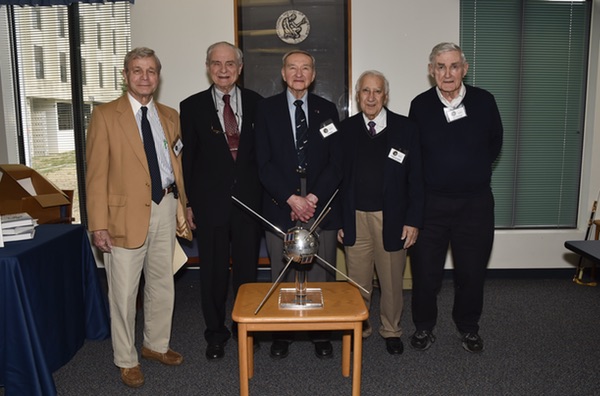Vanguard’s sixty-year spaceflight heritageby Richard Easton
|
| NRL employed a meticulous testing regime and used the tested parts in early upper atmospheric experiments. Testing was a culture and the final test was the launch. |
In spite of being only 16.2 centimeters in diameter and weighing 1.5 kilograms, Vanguard 1 carried the first solar cells into orbit. It had two transmitters, one powered by batteries and the other by the solar cells. The solar-cell-powered transmitter worked for six years. The transmitters on the three prior satellites worked for 22 days (Sputnik 1), about a week (Sputnik 2), and four months (Explorer 1). Vanguard 1 showed that the Earth was pear shaped and that the thin upper atmosphere extended out further than had been previously realized.
The Naval Center for Space Technology at NRL held a panel to celebrate the event and discuss its implications. Dr. David DeVorkin from the National Air and Space Museum talked about “Preserving NRL’s Design, Testing, and Engineering Legacy”. NRL employed a meticulous testing regime and used the tested parts in early upper atmospheric experiments. Testing was a culture and the final test was the launch. In contrast, NASA generally tested parts to destruction and used new parts in space experiments or launches.
Dr. Michael Neufeld from the National Air and Space Museum, perhaps best known for his biography of Wernher von Braun, spoke about, “The Vanguard Decision: Why NRL Won and Why von Braun Lost.” In the famous dinner party at Van Allen’s house in 1950, guests discussed the two polar years which were held in 1880–81 and 1930–31. They proposed having the equivalent of a new polar year 25 years later, which was generalized to the International Geophysical Year. The expected solar maximum would be an excellent time to study the Sun. Fred Singer, who attended the dinner at Van Allen’s house, put an IGY satellite launch on the agenda of international meetings in 1954. An Office of Naval Research meeting held June 25, 1954, was the origin of the Orbiter proposal for a Redstone rocket plus upper stages to launch the first American satellite. In the spring of 1955, Milt Rosen from NRL proposed an upgraded Viking, plus upper stages. The Air Force’s proposal for the Atlas ICBM had little internal support. Selection of the Orbiter for the first American satellite seemed inevitable.
Eisenhower approved the launch of a satellite in May 1955. An IGY satellite would set a precedent for the classified spy satellite that was being developed. The Stewart Committee voted 5–2, along service lines, for the NRL proposal. Homer Stewart and Clifford Furnas thought that the modified Vikings would require too much development. But the NRL proposal had better scientific potential, included a detailed tracking system (Minitrack) and more instruments on the satellites, and could create a more efficient rocket. Anti-German sentiment appeared to sway only one vote, so it was not decisive. However, there was a near-reversal of the decision in August. One compromise would have been to have the Army launch the NRL satellite. But ultimately, NRL prevailed in the 1955 competition.
| Space surveillance helped inspire Timation, and Timation, combined with the Air Force’s Project 621B, became GPS. Thus, the fruits of these early satellite launches and systems to track them continue to affect life in the 21st century. |
NRL’s historian, Dr. Angelina Callahan, spoke last about “Revolutionary Ideas Before Their Time—How Working Capital Funds Enable Disruptive R&D.” Callahan traced the origins of the Vanguard satellite system to 1945–47 satellite feasibility studies, in which Navy researchers recognized the utility of satellites for naval applications. Dedicated sponsorship for a prototype satellite system—a revolutionary idea—did not emerge until 1955, but from 1945 to 1955, NRL researchers laid the groundwork for a satellite system, proposing research projects in various fields including missile tracking, sounding rocket design, materials sciences, electronics design, optics, and space science. These seemingly unrelated research projects achieved the short-term needs of diverse sponsors, but also laid the groundwork for a prototype satellite system. Ten years of diversified research supported by different sponsors sustained satellite work “before its time.” Thus, when the Office of Naval Research asked NRL for a scientific satellite proposal, NRL researchers were able to bring together a proven launch vehicle stage, the Viking rocket, an improved tracking system, and scientific payloads already proven on sounding rockets, into a viable system proposal.
This longer history of the Vanguard satellite system provides a case study for understanding the value of industrial funding and working capital fund structures. These funding structures permit researchers the latitude to scope out both short- and long-term research objectives tailored to the needs of a wide variety of potential sponsors, building toward their own vanguard systems.
After the meeting, I spoke with colleagues who worked with my Dad, Roger Easton, on the Timation navigation system and much more: Pete Wilhelm, Ron Beard, and Lee Hammarstrom. I knew that my dad was thinking about Soviet spy satellites when he formulated the idea for what became the Naval Space Surveillance System in late 1957 and early 1958. The system had thee transmitters and six receiving stations along 33 degrees north latitude from San Diego to Georgia. Wilhelm added the detail that a powerful transmitter in Ft. Monmouth, New Jersey, bounced a signal off the Moon and revealed that the Sputnik satellite had a large object behind it: the third stage. That led my dad to realize that the Soviets could have a spy satellite orbiting over the United States and we might know nothing about it since early radio tracking systems required a signal transmitted from the satellite. His proposal was approved within a week. Space surveillance helped inspire Timation, and Timation, combined with the Air Force’s Project 621B, became GPS. Thus, the fruits of these early satellite launches and systems to track them continue to affect life in the 21st century.
